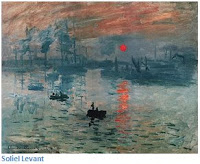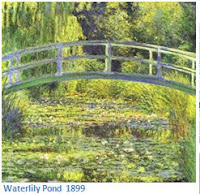 ‘Water-lilies’ by Claude Monet is one of a range of very well know paintings the founder of French art impressionism has produced, others including:
‘Water-lilies’ by Claude Monet is one of a range of very well know paintings the founder of French art impressionism has produced, others including: And it was Monet’s ‘Soliel Levant’ painting that brought about the title of the 19th century art movement ‘Impressionism’. There are various aspects which characterize an impressionist painting. One involves the painting having an open composition as can be seen in ‘water-lilies’. Looking at the painting, Monet has covered the entire canvas to portray the surface of water (with water lilies). By doing this, the painting allows the audience to feel a sense of another world, ‘a world in itself’. Furthermore, looking at the painting as a whole, the open composition combined with the use of soft colours, textures and blending of the colours makes the audience feel a sense of with the immersion into the painting. ‘Impressionist paintings incorporate the qualities of sketches’. This ‘sketchy’ aspect is shown through his brush strokes made in the painting which illustrates that Monet has made ‘no attempt to blend the pigment to create smooth tonal gradations and the optical accurate scene’.
Selecting an aspect of the painting, we can see that perspective is also visible in the painting through the positioning of the water lilies along with the directions of the brush strokes giving a real sense of a surface to the audience.
In addition, Depth is given to the painting by the use of blue below the brightly painted water lilies.
Sources used:
Primary Research
· Visiting the ‘Tate Modern’ and view the paintings first hand
Secondary Research
· http://books.google.co.uk/books?id=aSV_y8aSbycC&pg=PA701&dq=claude+monet&as_brr=3
(‘Gardner’s Art Through the Ages: The Western Perspective’, 2005, By Helen, Fred S. Kleiner, Christin J. Mamiya, Thomson Wadsworth, p.g 701)




No comments:
Post a Comment